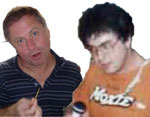Clams Ahoy!
Everything you always wanted to know about Clams but were afraid to ask!!
Amazing Clams Facts
Clams are among the oldest living things. The clam has been around since the early Paleozoic Era, Ordovician period (468-450 million years ago) and has changed little biologically in that time. Dinosaurs ate clams. So did Cro-Magnon man, so does the leadership of our country and so does H. sapiens or us Regular Joes. Also Frenchmen.
Clam means “tight or closed,” and is from the Anglo-Saxon. The word appears in the epic poem Beowulf.
Clam shells are sharp enough that early Man used them to shape wood in the Americas and Africa, thirty-five thousand years ago.
This just in: if a bill now in committee hearings becomes law, the hard-shelled clam will become the state shellfish of Massachusetts. According to the Boston Globe (June 6 2011), the bill “is scheduled for a public hearing today before the Committee on Tourism, Arts and Cultural Development. Taunton students have long pushed for the designation.” In a related story, Boston Baked Beans were de-listed today as the state’s official legume in return for carbon offsets.
Clams are an excellent source of nutrition. They are 100% protein, and very high in trace minerals such as iodine. Clams usually taste good: there are shellfish that don’t. Cockles do not taste good even under heavy assault from butter and herbs ... reasonable people can disagree. But it is a fact the Irish did not eat cockles unless they had to, hence the derogatory term “famine food.” This despite their nutritional value. But because clams are delicious, it is all the easier to enjoy their health benefits.
Observant Jews cannot eat clams because they are treyf, ritually forbidden. This proscription is based on references in the Torah, the first five books of the Bible.
Clams can be prepared using virtually all cooking methods or no cooking at all. Littlenecks on the half shell, which is to say raw, is the best way to enjoy littlenecks. Otherwise baked, boiled, steamed, fried, sauteed and baked stuffed clams are all popular, as is clam-flavored vegetable juice.
Clams for some reason are often the subject of jokes and aphorisms. “Happy as a clam at high tide.” How happy are clams? Have you ever heard a clam express an opinion on the subject? “Clam up.” No you have not. “Clammy.” This mean cold, grasping and unpleasant, such as early evening fog. Johnny Hart’s comic strip B.C. often features clams who walk on little tiny feet and spout wisecracks. No one is seen eating clams in B.C. which is really a shame. “Clams got feets!” is funny, once. Woodchucks are funny too, but neither clams nor woodchucks are star material. They belong in supporting roles. We all remember that giant clam that almost ate Robin, it did its part and was never heard from again, a fine example really.
Wampum is a form of jewelry created by the Wampanoag, Narragansett and other tribes, on Cape Cod and elsewhere. Blue-and white-colored part of quahog shells are split off then polished to a fine sheen and cut into shapes. Wampum earrings, necklaces and cuff links remain popular. The word quahog is a contraction of the name given the animal by Narragansett Indians, “poquahock” (spellings vary). There is some evidence bead strands of wampum were used for communication among Indian tribes, with the order and placement of beads used as a symbolic code. Although the blue-colored portion of clam shells is most often seen as the basis for wampum ornamentation, the word wampum in the Narragansett tongue means “white.”
 Hi,
we are Ted and John, just two guys who love Clams and other seafood.
Hi,
we are Ted and John, just two guys who love Clams and other seafood.